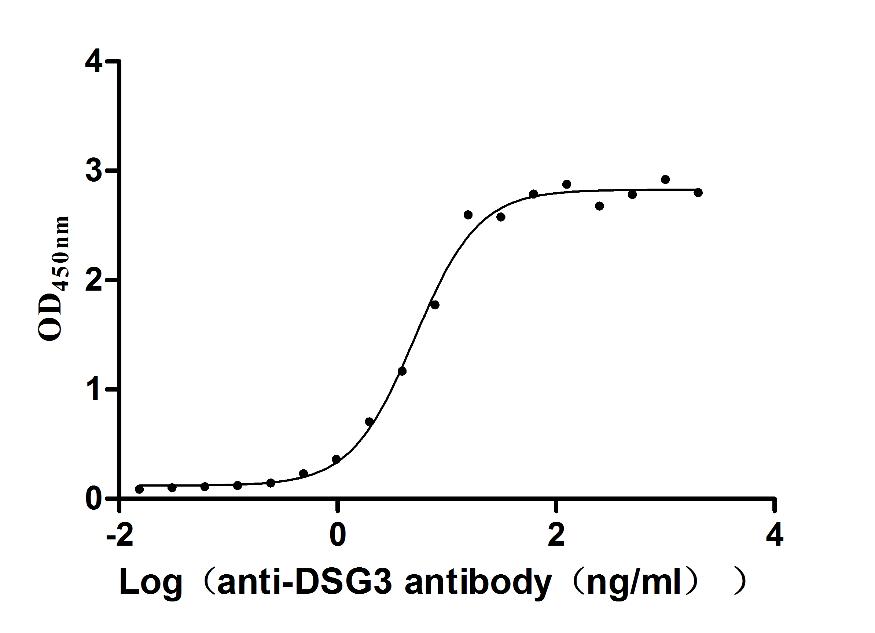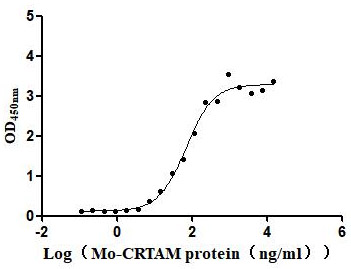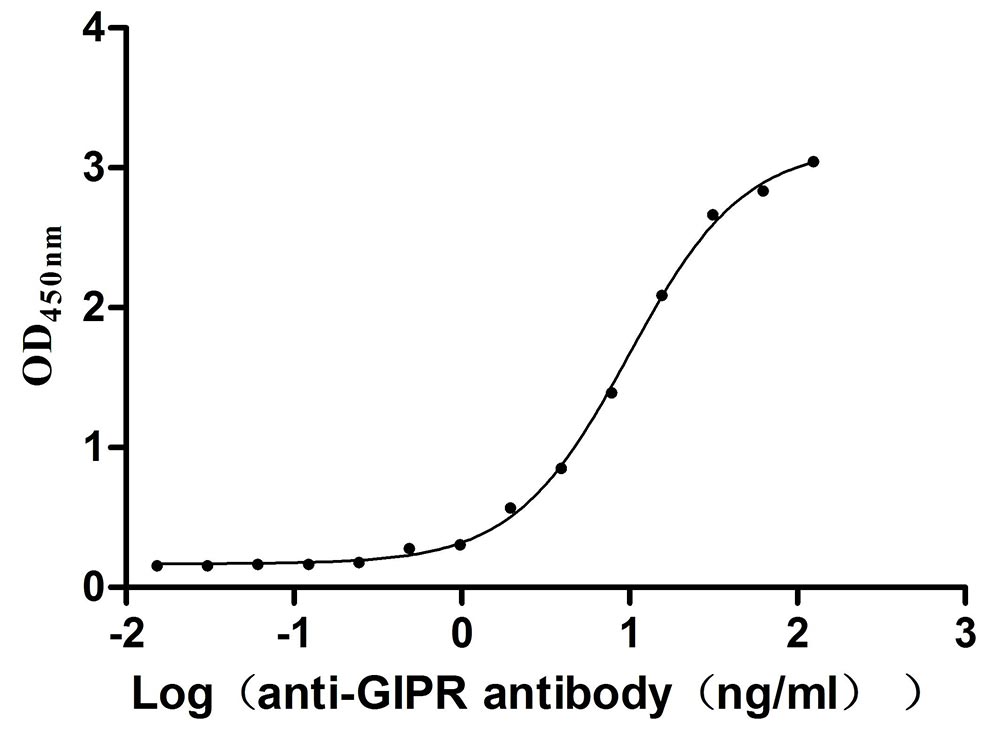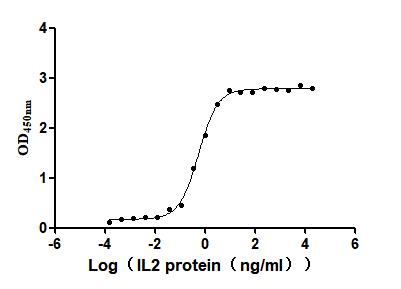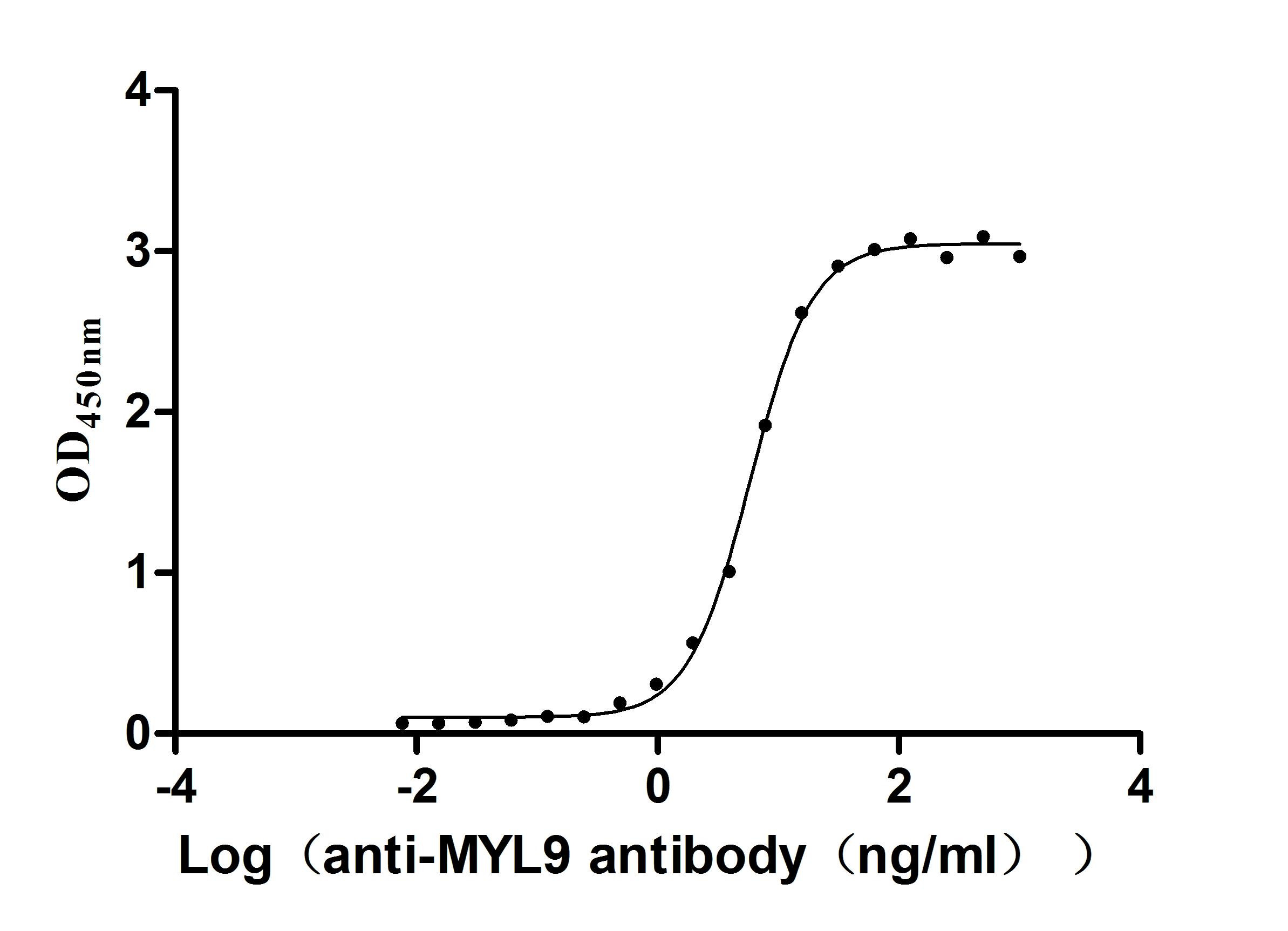Recombinant Human Paired box protein Pax-4 (PAX4)
-
中文名稱:人PAX4重組蛋白
-
貨號:CSB-YP017490HU
-
規(guī)格:
-
來源:Yeast
-
其他:
-
中文名稱:人PAX4重組蛋白
-
貨號:CSB-EP017490HU
-
規(guī)格:
-
來源:E.coli
-
其他:
-
中文名稱:人PAX4重組蛋白
-
貨號:CSB-EP017490HU-B
-
規(guī)格:
-
來源:E.coli
-
共軛:Avi-tag Biotinylated
E. coli biotin ligase (BirA) is highly specific in covalently attaching biotin to the 15 amino acid AviTag peptide. This recombinant protein was biotinylated in vivo by AviTag-BirA technology, which method is BriA catalyzes amide linkage between the biotin and the specific lysine of the AviTag.
-
其他:
-
中文名稱:人PAX4重組蛋白
-
貨號:CSB-BP017490HU
-
規(guī)格:
-
來源:Baculovirus
-
其他:
-
中文名稱:人PAX4重組蛋白
-
貨號:CSB-MP017490HU
-
規(guī)格:
-
來源:Mammalian cell
-
其他:
產(chǎn)品詳情
-
純度:>85% (SDS-PAGE)
-
基因名:PAX4
-
Uniprot No.:
-
別名:KPD; MGC129960; MODY9; Paired box 4; Paired box gene 4; paired box homeotic gene 4; Paired box protein Pax-4; Paired domain gene 4; Pax4; PAX4_HUMAN
-
種屬:Homo sapiens (Human)
-
蛋白長度:Full length protein
-
表達區(qū)域:1-350
-
氨基酸序列MHQDGISSMN QLGGLFVNGR PLPLDTRQQI VRLAVSGMRP CDISRILKVS NGCVSKILGR YYRTGVLEPK GIGGSKPRLA TPPVVARIAQ LKGECPALFA WEIQRQLCAE GLCTQDKTPS VSSINRVLRA LQEDQGLPCT RLRSPAVLAP AVLTPHSGSE TPRGTHPGTG HRNRTIFSPS QAEALEKEFQ RGQYPDSVAR GKLATATSLP EDTVRVWFSN RRAKWRRQEK LKWEMQLPGA SQGLTVPRVA PGIISAQQSP GSVPTAALPA LEPLGPSCYQ LCWATAPERC LSDTPPKACL KPCWDCGSFL LPVIAPSCVD VAWPCLDASL AHHLIGGAGK ATPTHFSHWP
-
蛋白標簽:Tag?type?will?be?determined?during?the?manufacturing?process.
The tag type will be determined during production process. If you have specified tag type, please tell us and we will develop the specified tag preferentially. -
產(chǎn)品提供形式:Lyophilized powder
Note: We will preferentially ship the format that we have in stock, however, if you have any special requirement for the format, please remark your requirement when placing the order, we will prepare according to your demand. -
復溶:We recommend that this vial be briefly centrifuged prior to opening to bring the contents to the bottom. Please reconstitute protein in deionized sterile water to a concentration of 0.1-1.0 mg/mL.We recommend to add 5-50% of glycerol (final concentration) and aliquot for long-term storage at -20℃/-80℃. Our default final concentration of glycerol is 50%. Customers could use it as reference.
-
儲存條件:Store at -20°C/-80°C upon receipt, aliquoting is necessary for mutiple use. Avoid repeated freeze-thaw cycles.
-
保質(zhì)期:The shelf life is related to many factors, storage state, buffer ingredients, storage temperature and the stability of the protein itself.
Generally, the shelf life of liquid form is 6 months at -20°C/-80°C. The shelf life of lyophilized form is 12 months at -20°C/-80°C. -
貨期:Delivery time may differ from different purchasing way or location, please kindly consult your local distributors for specific delivery time.Note: All of our proteins are default shipped with normal blue ice packs, if you request to ship with dry ice, please communicate with us in advance and extra fees will be charged.
-
注意事項:Repeated freezing and thawing is not recommended. Store working aliquots at 4°C for up to one week.
-
Datasheet :Please contact us to get it.
相關(guān)產(chǎn)品
靶點詳情
-
功能:Plays an important role in the differentiation and development of pancreatic islet beta cells. Transcriptional repressor that binds to a common element in the glucagon, insulin and somatostatin promoters. Competes with PAX6 for this same promoter binding site. Isoform 2 appears to be a dominant negative form antagonizing PAX4 transcriptional activity.
-
基因功能參考文獻:
- genetic association studies in population in Republic of Korea: Data suggest that SNPs in PAX4 and GLP1R are associated with type 2 diabetes (T2D) in the population studied. In genome-wide associations, PAX4 Arg192His increased risk of T2D; GLP1R Arg131Gln decreased risk of T2D. (PAX4 = paired box 4 protein; GLP1R = glucagon-like peptide 1 receptor) PMID: 29941447
- The rs10229583 polymorphism near PAX4 is associated with gestational diabetes mellitus in Chinese women. PMID: 28730907
- Study identified the association of a PAX4 Asian-specific missense variant rs2233580 with type 2 diabetes in an exome-chip association analysis, supporting the involvement of PAX4 in the pathogenesis of type 2 diabetes. PMID: 27744525
- Viability of beta-cell was reduced under glucotoxic stress condition for the cells overexpressing either PAX4 R192H or PAX4 P321H or both. Thus these PAX4 polymorphisms may increase T2D risk by defective transcription regulation of target genes and/or decreased beta-cell survival in high glucose condition. PMID: 27334367
- PAX4 IVS7-1G>A contributes to the pathogenesis of diabetes in this maturity-onset diabetes of the young, type 9 family through beta-cell dysfunction PMID: 25951767
- The PAX4 variant rs6467136 was associated with the therapeutic effect of rosiglitazone in Chinese T2DM patients. PMID: 24752311
- PAX4-miR-144/451-ADAMs axis regulates human epithelial cancer metastasis PMID: 25151965
- These data suggest that acute PAX4 overexpression can reduce expression of aristaless related homeobox and glucagon during embryonic stem cell differentiation resulting in improved numbers of unihormonal insulin-positive cells. PMID: 25483960
- Tph1 and increased EC cell number occurred before the onset of obesity and hyperleptinemi. In addition, leptin deficiency was associated with reduced Pax4 mRNA, oral leptin treatment enhanced both Tph1 and Pax4 mRNA. PMID: 24468700
- MAFA nuclear expression in pancreatic alpha and beta cells, and the percentage of alpha cells expressing PAX4 are altered in patients with type 2 diabetes. PMID: 24013263
- PAX4 R192H polymorphism generated a protein with defect in transcriptional repressor activities on its target genes, which may lead to beta-cell dysfunction associated with maturity onset diabetes of the young and early onset-age of type 2 diabetes. PMID: 22521316
- A1168C polymorphism in PAX4 gene may not play an essential role in the genetic susceptibility of the islet autoantibody-negative ketosis-prone diabetes in Chinese Han population. PMID: 20360641
- A novel mutation of PAX4 is likely to be associated with diabetes in this Japanese family. PMID: 21263211
- study did not detect causal mutations in the PAX4 gene in a large group of Czech MODYX probands, which may suggest-together with data from other European populations- MODY in Caucasians could only very rarely, if ever, be attributed to PAX4 mutations PMID: 21059099
- PAX4 R192H mutation (rs2233580) was significantly associated with impaired glucose tolerance in childhood acute lymphoblastic leukemia. PMID: 20485196
- The A1168C single nucleotide polymorphism in PAX4 gene may not play an essential role in genetic T1DM susceptibility in Chinese Han population PMID: 17633464
- Sixteen single-nucleotide polymorphisms(SNPs) were evaluated for IRS1 and 10 for PAX4. Transmission disequilibrium testing neither show type I diabetes association of SNPs in the two genes, nor did haplotype analysis. PMID: 19956100
- Four genes, PCSK1, (P=0.008), EGFR,(P=0.003), PAX4,(P=0.008), and LYN,(P=0.002) consistently yielded statistical evidence for association with longevity. PMID: 19641380
- Beta-cell dysfunction in late-onset diabetic subjects carrying homozygous mutation in transcription factor Pax4. PMID: 12200761
- The R121W mutation in PAX4 is a predisposing factor for the development of type 2 diabetes in Okinawans. PMID: 12604352
- The expression of this gene is regulated by REST protein. PMID: 12829700
- Located at 7q32 and participates downstream of ISL1 in the transcription factor cascade critical to beta-cell development. Association with type 1 diabetes was also observed using the transmission disequilibrium test for two haplotypes at the PAX4 locus. PMID: 15161765
- The mechanism by which the beta-cell transcription factor Pax4 influences cell function/mass was studied in human islets of Langerhans. PMID: 15596543
- Pax4 is an essential regulator of pancreatic beta-cell development [review] PMID: 15650323
- C/C genotype of the A1168C polymorphism in PAX4 can be viewed as a predisposition marker that can help to detect individuals prone to develop type 1 diabetes. PMID: 15834548
- A predisposition marker for susceptibility for type 1 diabetes. PMID: 15838687
- The data indicate that the +1,168 C/A variant of PAX4 gene does not play any essential role in genetic type 1 diabetes susceptibility. PMID: 16123375
- The Arg121Trp variant in the PAX4 gene is associated with beta cell dysfunction in Japanese subjects with type 2 diabetes. mellitus. PMID: 16423628
- activin A enhances PAX4 expression by enhanced transactivation of E47/E12 proteins and might result in a cumulative transactivation of the promoter PMID: 16546275
- Forced expression of the PAX4 gene in the HEK293 and SHSY/610 cell lines conferred positive effects on cell growth. This profile of PAX4 thus corresponds to that of a candidate oncogene in hematologic malignancies. PMID: 16701883
- two possible pathogenic mutations of PAX4, R164W, and IVS7-1G>A; for one, we have shown evidence of segregation with diabetes and a functional impact on PAX4 activity and polymorphism R192H might influence the age at onset of diabetes PMID: 17426099
- Pax4 protein transduction could be a safe and valuable strategy for protecting islet cell growth in culture from apoptosis and promoting islet cell differentiation. PMID: 17717051
- pax4 gene expression is epigenetically regulated and induced by physiological stimuli through the concerted action of multiple signalling pathways. PMID: 17989064
- Constitutive expression of Pax4 in HESC substantially enhances their propensity to form putative beta-cells. Our findings provide a novel foundation to study the mechanism of pancreatic beta-cells differentiation during early human development PMID: 18335054
- PAX4 has the potential to function as a tumor suppressor in human melanoma. PMID: 18949370
顯示更多
收起更多
-
相關(guān)疾病:Diabetes mellitus, non-insulin-dependent (NIDDM); Diabetes mellitus, insulin-dependent (IDDM); Diabetes mellitus, ketosis-prone (KPD); Maturity-onset diabetes of the young 9 (MODY9)
-
亞細胞定位:Nucleus.
-
蛋白家族:Paired homeobox family
-
數(shù)據(jù)庫鏈接:
Most popular with customers
-
Recombinant Human Tumor necrosis factor ligand superfamily member 9 (TNFSF9), partial (Active)
Express system: Mammalian cell
Species: Homo sapiens (Human)
-
Recombinant Human V-set and immunoglobulin domain-containing protein 4 (VSIG4), partial (Active)
Express system: Mammalian cell
Species: Homo sapiens (Human)
-
Recombinant Human Dickkopf-related protein 1 (DKK1) (Active)
Express system: Mammalian cell
Species: Homo sapiens (Human)
-
Recombinant Human Desmoglein-3 (DSG3), partial (Active)
Express system: Baculovirus
Species: Homo sapiens (Human)
-
Recombinant Mouse Cell adhesion molecule 1 (Cadm1), partial (Active)
Express system: Mammalian cell
Species: Mus musculus (Mouse)
-
Recombinant Mouse Gastric inhibitory polypeptide receptor (Gipr), partial (Active)
Express system: Mammalian cell
Species: Mus musculus (Mouse)
-
Recombinant Human Interleukin-2 (IL2) (Active)
Express system: Mammalian cell
Species: Homo sapiens (Human)
-
Recombinant Human Myosin regulatory light chain 12A (MYL12A) (Active)
Express system: E.coli
Species: Homo sapiens (Human)


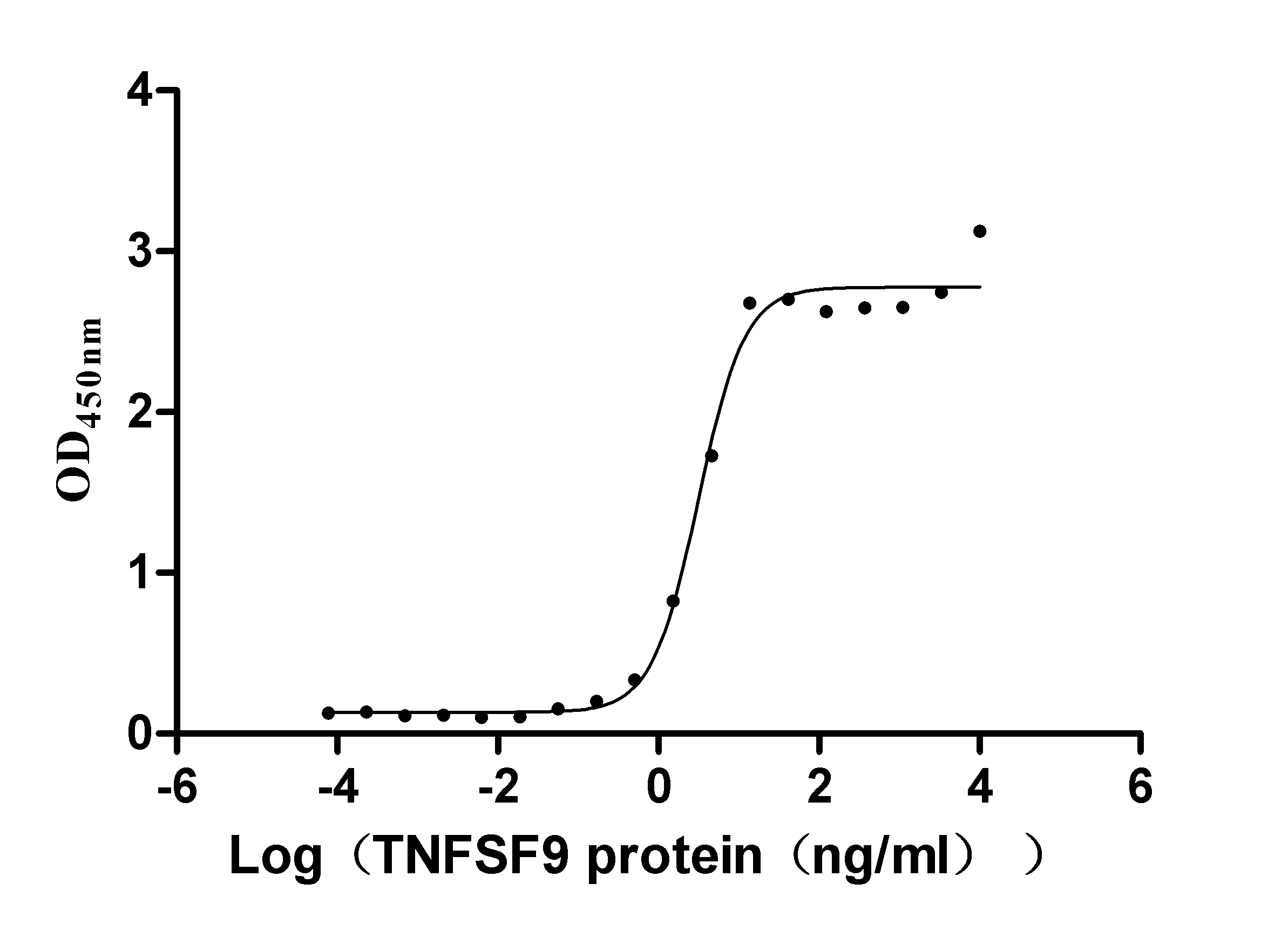

-AC1.jpg)
